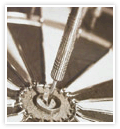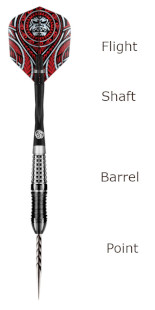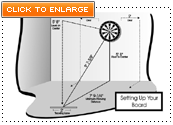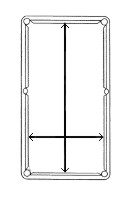Hit the Bull! Answers to all your dart questions
John Roufas2023-09-29T22:36:14-05:00Hit the Bull! Answers to all your dart questions

Darts is one of the most popular participation sports in the world. Here’s a guide to everything you ever wanted to know about darting. From hanging your board to fine tuning your dart, get the tips that will have you throwing 180’s in no time.
Creating the Perfect Space
Where do I set up my dart board?
Once you have the right dart board (see Dartboard Selection and Care), choose an appropriate location in a low traffic area. At home, you will need a space approximately 4 feet by 11 feet with enough ceiling height to throw the dart with an arc and possibly hang lighting (check out some easy to install lighting options here Dart Lighting). For a league space, you should consider speaking with the league representative for their minimum requirements.
Also, consider your flooring. Hardwood and linoleum flooring will show holes, darts bounce out from time to time. A concrete, stone, or tile floor can break dart tips and damage them quickly. In most cases should consider a “dart mat”. This will not only protect your floor and darts but mark the proper distance to the throw line (check out some options in our Mats and Throw Lines).
Hanging the Board: The board needs to be hung exactly 5 foot 8 inches from the floor to the CENTER OF THE BULLSEYE.
Marking the Throw Line: The throw line, also known as the oche (pronounced “okkey”), or toe-line, should be about 2-3 feet wide. If you do not use a dart mat, you can use a throw-line sticker, a fixed piece of wood or metal or even tape. For a less permanent fixture on your floor, consider a Laser Oche, which projects a line from under your board onto the floor without any need for tape.
Whatever you use, it should be placed exactly 7 feet 9 and 1/4 inches from the FACE of the board for a standard steel-tipped setup (NOTE: Some British pubs use an 8 foot or 8 foot 6 inch measurement for steel tip darts). For soft-tipped darts, the line should be 8 feet from the FACE of the board.
The proper way to measure this distance is to use an Oche Tape Measure, which measures from the center of the bull to the tip of the toe line on the floor. That measurement is 9 feet 7-3/8 inches.
How do I mount the Board?
The dartboard comes with a bracket for the wall, which will sit 5 feet 8 inches from the floor. Ideally, this bracket should be fitted directly into a stud or sturdy mount, as it will hold the board’s weight. If you are placing your board inside a cabinet or other type of backed frame, you will need to mount the cabinet in such a way that the bracket will sit 5 feet 8 inches from the floor.
Either a simple screw or a professional disk will mount to the center of the back of your dartboard. This disk or screw will sit in the bracket, and the board can be rotated on this screw as needed.
Once the board has been properly mounted to the wall, you will need to add spacers between the board and the wall to ensure it is flat and secure as darts hit it. The spacers are usually provided with the board’s hardware or might be adjustable feet integrated into the back of the board. If you are in a pinch and it is league night, shove some coasters in there.
Choosing your Darts
What is the difference between brass and tungsten?
Tungsten is twice as dense as brass. Barrels made with tungsten will, therefore, be half the size given the same weight, resulting in closer grouping and allows for far more refined shapes and grips to choose from. Beginners often start with brass, steel or nickel/silver darts, but will advance to more expensive tungsten darts once they have developed a consistent throwing motion and basic playing knowledge. At that point a more customized dart might improve performance.
Why do darts come in different percentages of tungsten?
The higher the percentage, the slimmer the dart will be, resulting in increase scoring chances. 97% is the highest percentage tungsten that is commercially produced and 70% is the minimum. Anything made of lesser percentage than this is too bulky for the player who might as well continue with brass.
What weight of darts is best for me?
Generally men use darts weighing 22 to 25 grams while women enjoy sets that are slightly heavier averaging 24 to 26 grams. The best way to select a new set of darts is to try out a variety of styles and weights to find the ones best suited to you.
Tuning your Setup

Once your board is in place, and you have your darts, now the refining begins.
Your barrel is not going to change, but you can change the way your dart speed and how they land in the board by trying different flights and shafts.
This is a trial-and error process, and should be done by changing only one component at a time, when you are throwing in a relaxed consistent situation without interruption.
While there is no perfect angle for the dart to enter the board, darts that go in at a negative angle are more likely to fall out, and those that go in at a steep angle are more likely to bounce out and tend to create difficulty when grouping. 20 degrees is a good starting point, but as players become more experienced, this is usually reduced to less than 10 degrees.
As each player’s throw is unique and each darts is weighted and shaped differently, it is not possible to accurately predict how a flight or shaft will affect each player’s throw, but there are some general guidelines to get you started.
Flights – See our Flights Here
The larger the flight or more wing surface area will have more air resistance. This slows down a dart and will cause it to have a greater angle of entry. There is a standard shape, but most companies will now offer a variety of subtly different shapes which reduce or possibly increase this resistance.
A possible drawback to the smaller, faster flight is that it provides less stabilizing effect for the beginning player and the dart will will fly less straight and be likelier to bounce out.
There are also many little accessories you can try to protect the flight or improve its ability to stay on the shaft.
Shafts – See our Dart Shafts Here
Shorter shafts have the same effect, as bringing the flight closer to the barrel will also decrease drag. Shafts come in multiple sizes, sometimes as Min, Extra Short, Short, Medium, Long or possibly measured in millimeters, depending on the manufacturer.
Shaft and flight materials will also affect the throw. Every year, manufacturer’s come up with new ways to improve performance and possibly durability, but with each new material comes a new weight, which will obviously change the dart’s overall balance from front to back.
In all instances, we suggest you begin with standard flights and medium shafts until you get a baseline to start working with and tune from that.
Again, there are numerous little accessories to improve shaft performance.
One Final Thing to Remember
Fortunately, all flights and shafts are going to eventually break or bend. You are throwing them at the wall and sometimes even hitting them with pointy steel objects. This means you will have plenty of opportunity to try out a new set again and again.






